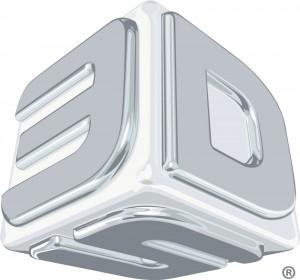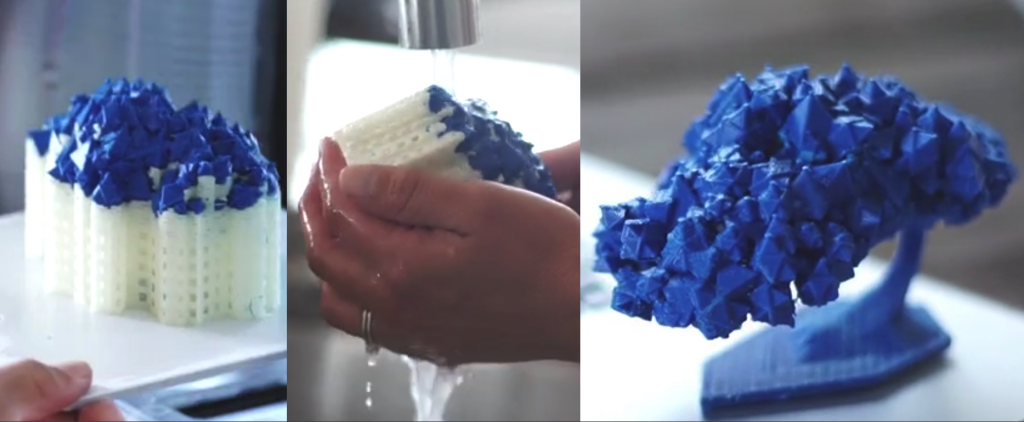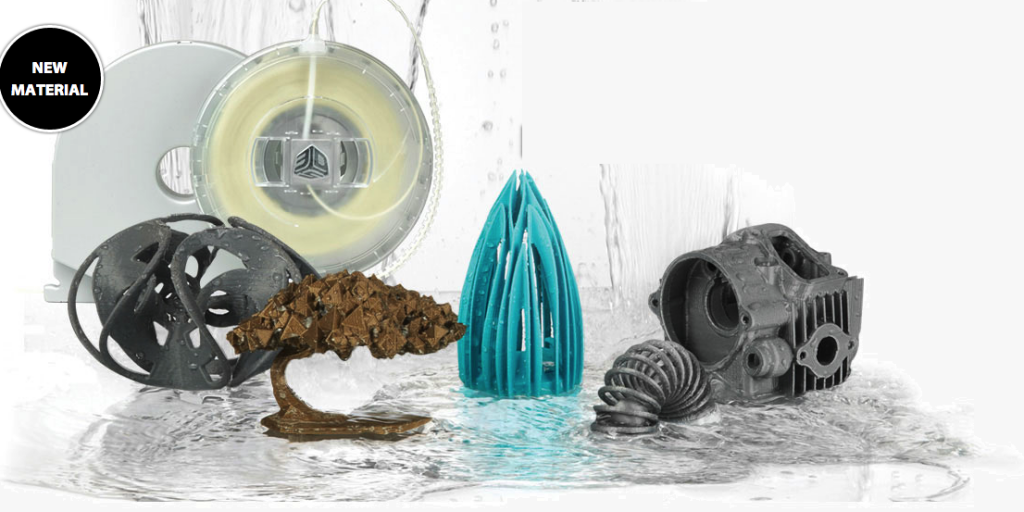 Recently we reported on a new 3D printing material released by 3D Systems, called “Infinity Rinse-Away Water-Soluble Support Material” (INF). The material is truly the ultimate time saver when it comes to 3D printing objects that require support. Rather than having to spend hours chipping away at stubborn plastic, it can simply be rinsed away with tap water. After covering the story, I thought to myself, “I’d love to sit down with the man who invented this material”. Then a few hours later, my wish actually came true.
Recently we reported on a new 3D printing material released by 3D Systems, called “Infinity Rinse-Away Water-Soluble Support Material” (INF). The material is truly the ultimate time saver when it comes to 3D printing objects that require support. Rather than having to spend hours chipping away at stubborn plastic, it can simply be rinsed away with tap water. After covering the story, I thought to myself, “I’d love to sit down with the man who invented this material”. Then a few hours later, my wish actually came true.
Marty Johnson, is his name, and principle engineering is his game. Johnson actually is a Principle Engineer for 3D Systems, and he is also one of the major proponents of a new webinar series that 3D Systems is creating for Desktop Engineering, focused on the performance advantages of 3D digital design and fabrication tools such as the CubePro 3D printer. The series looks to have plenty of potential, especially for owners or prospective owners of a Cube 3D printer. The first of series is slated to begin tomorrow, with the webinar entitled “3D Printing with the Pros” starting at 11 am EDT (5 pm CET).
Our interview with the man, the myth, the legend, Marty Johnson, can be found below in its entirety.
What was your motivation in creating the new Infinity material?
Johnson: This was really a team effort. However, one thing that motivated us to provide a better support solution, that ultimately ended up being INF supports, was the fact we were not able to print all geometries as well as we would have liked to be able to. This includes overhangs in hard to reach areas, tubular parts, and figurine type parts. We wanted to be able to print parts more reliably and be able to clean supports from them more easily. Sometimes these were opposing propositions. In addition, one big question in extrusion printing has always been, “How do I get a better bottom surface?”.
What excited you about the material?
Johnson: The simplicity of the support solution and the vast applications are huge. The supports pick up the bottom surface of the part without excess filters and manipulation in the SW. The INF solution also provides support for both the flat and curved bottom surfaces. With these items, we can now print the overhangs, tubular shapes, and other geometries AND get the supports off without a lot of excess post processing which may damage the finished part.
What does it allow users to do that they couldn’t do before?
Johnson: Imagine having an assembly of moving parts drawn up in CAD but having to create modifications to make it printable. Now the user can create the moving assembly, and simply print with INF supports. Then the supports can be rinsed away to free the moving parts. This is a brand new realm for 3D printing for us to provide, as the limits on printing have been widen tremendously. The imagination of the user is now the biggest limit to what can be printed.
I am very excited to see what people do with this, as there are many, many creative people in the 3D printing world and soon to be in the 3D printing world. The more tools we supply and continue to simplify ease of printing, I feel more and more people will adapt to 3D printing and create applications for 3D printing. The application of 3D printing is just scratching the surface.
We have been working on this for about a year. We wanted the use of INF material to require little extra knowledge to be able to use and make it safe for the user. The ability to remove supports without chemicals and to make it safe for home sinks was a priority.
Was there a major obstacle that you and the team came across?
Johnson: We spent a lot of time getting the best profile to support the most geometries. That means, “how do we support small features and large flats with one click of automatic support generation?” We place a large focus on making it where the user does not have to be an expert to use our printer and the materials. The focus is to allow the user to print and enjoy the creation they printed.
In addition, support removal was a focus. The removal has to balance with being able to provide the ample support to print the desired geometry. This, when a user removes supports there should be ways to get the material off of the part easily, and in ways such that the part itself is not damaged. Sometimes soaking the part longer is required, and sometimes more actively removing the support is required.
What are your ultimate goals and plans with the webinar series? How many webinars will there be?
Johnson: The ultimate goal of the webinars is to spotlight innovation, benefits, and features of a printer and\or a material, and why that printer\material is positioned as the ultimate solution for Engineers, Hobbyists, Novices, and Families alike for desktop 3D printing.
As we make new discoveries and advances in 3D printing at 3D Systems, how can we better inform the user and spark their creativity and innovative energy to apply to 3D printing these new discoveries? The webinars should help the user get more out of their 3D printer.
A new power user each month will be featured and how that power user is using 3D printing to impact work flow and application.
Any other similar filaments in the works that you can speak of?
Johnson: Nylon material was shown at CES 2015 and is something to really get excited about. The strength and capability of nylon will open the CubePRO up to a new segment of application. The nylon parts are sturdy, durable, and ready to be put to work once printed, and they will be applied in a variety of ways to the engineering world, home innovators, and enthusiasts alike. I am very eager to see the affect this material will have in 3D printing applications.
Do you look forward to getting your hands on the new Infinity filament? Discuss in the Infinity Rinse-Away Support Material forum thread on 3DPB.com.
Subscribe to Our Email Newsletter
Stay up-to-date on all the latest news from the 3D printing industry and receive information and offers from third party vendors.
You May Also Like
Gorilla Sports GE’s First 3D Printed Titanium Cast
How do you help a gorilla with a broken arm? Sounds like the start of a bad joke a zookeeper might tell, but it’s an actual dilemma recently faced by...
Nylon 3D Printed Parts Made More Functional with Coatings & Colors
Parts 3D printed from polyamide (PA, Nylon) 12 using powder bed fusion (PBF) are a mainstay in the additive manufacturing (AM) industry. While post-finishing processes have improved the porosity of...
$25M to Back Sintavia’s Largest Expansion of Metal 3D Printing Capacity Since 2019
Sintavia, the digital manufacturing company specializing in mission-critical parts for strategic sectors, announced a $25 million investment to increase its production capacity, the largest expansion to its operations since 2019....
Velo3D Initiates Public Offering in a Bid to Strengthen Financial Foundations and Drive Future Growth
Velo3D (NYSE: VLD) has been among a number of publicly traded 3D printing firms that have attempted to weather the current macroeconomic climate. After posting a challenging financial report for 2023,...































